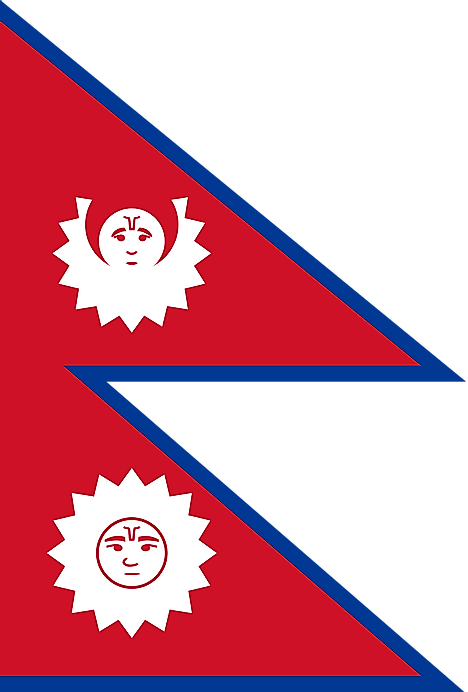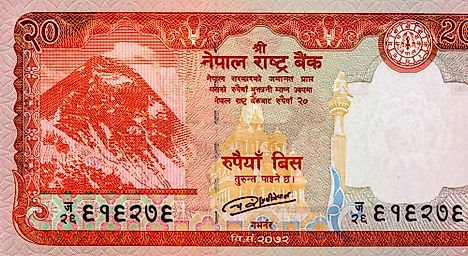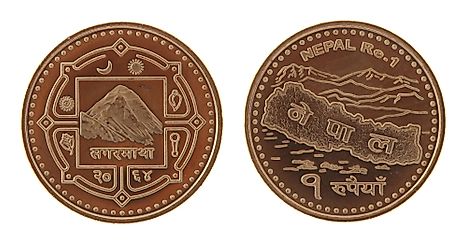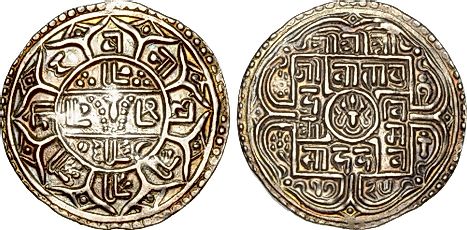Flags, Symbols, & Currencies of Nepal
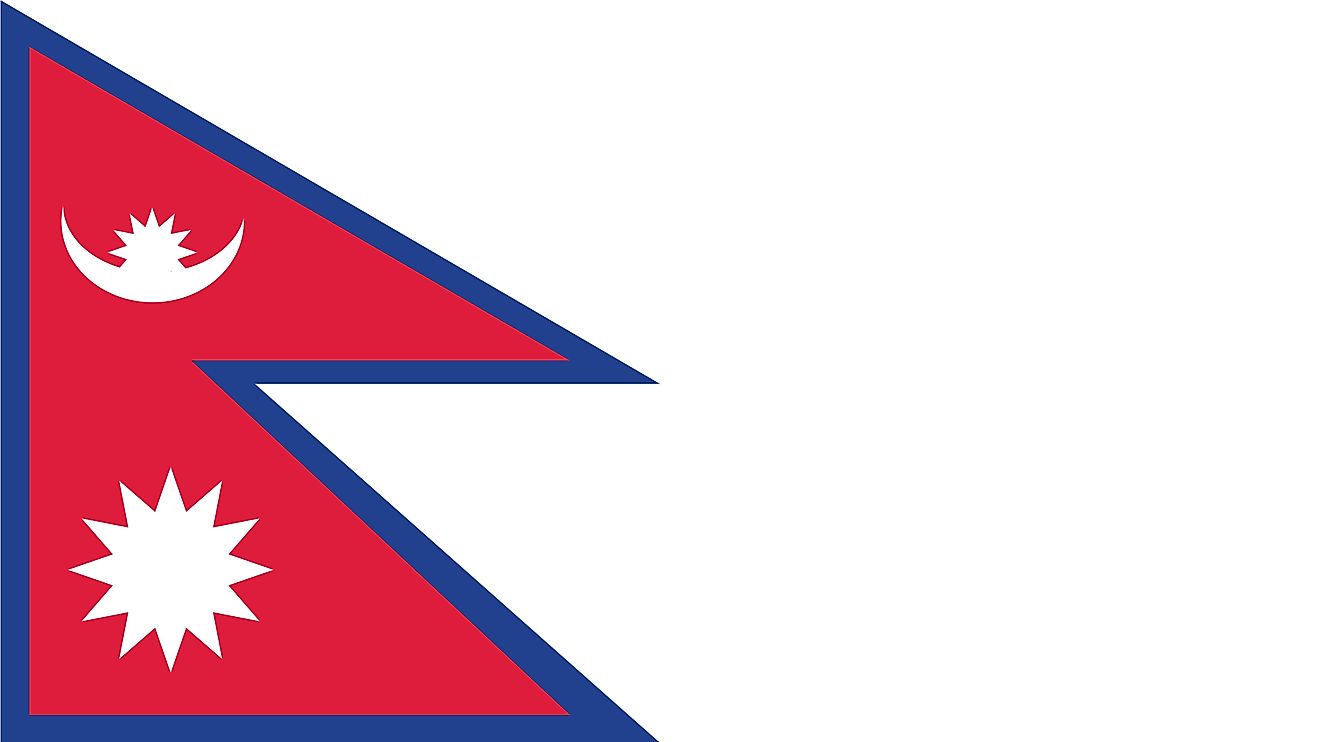
The Nepal flag was officially adopted on December 16, 1962. The flag is unique in that it is the only flag in the world that is non-quadrilateral in shape. It is, in fact, a combination of two pennons or pennants that form a double pennon. Originally, the flag had two separate pennons that represented the Rana Dynasty’s rival branches. In the last century, the two pennons were joined together but the new version of the flag was only adopted in 1962 when a constitutional form of government was established in Nepal. A pennon refers to a flag that is larger at the hoist than at the fly. The upper section of the flag is thus smaller than the lower one. The background color of the flag is crimson. The borders of the entire flag are in blue. The upper segment of the flag features a stylized moon. The lower segment has a white sun with 12 rays. Prior to 1962, the emblems of the flag, that is, the moon and the sun featured faces of humans. These were, however, removed in the modern version to modernize the flag.
Symbolism
Every part of the flag has its own meaning. The triangular shape of the flag’s pennons symbolizes the Himalayas. The crimson red color of the flag represents the color of Nepal’s national flower, the rhododendron. It is also believed to symbolize the bravery of the people of the country. The blue border represents the color of peace and harmony according to Nepali culture. The celestial bodies in the Nepalese flag are indicators of the permanence of the Himalayan nation. Just like the sun and the moon, the country will survive for ages. The moon is also an indicator of purity and calmness of the people of Nepal. At the same time, their fierce determination is symbolized by the stylized sun. The moon and the sun also represent the variable climate of the country. They represent the cool weather of the mountains and the warm weather of the Terai lowlands of Nepal, respectively.
History of the flag
Prior to the establishment of British rule in much of the Indian subcontinent, Nepal was one of the many independent states in the region. Nepal had its own flag representing the ruling dynasty of the region. During the British rule, Nepal managed to remain independent although it served as a buffer state between China and India. Despite the fact that flags of most other countries in the region were replaced by the flag of Imperial Britain during the colonial rule, Nepal managed to keep its traditional flag. There were, however, some changes incorporated in the flag of Nepal over the centuries. The present version flag was formally adopted on December 16, 1962.
Symbols of Nepal
National Coat of Arms of Nepal
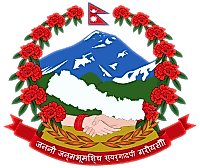
Nepal's coat of arms was introduced on December 30, 2006. It is composed of a garland of rhododendrons encompassing Mount Everest and the hands of a male and female (to symbolize gender equality). The red scroll making up the base bears the writing: "The mother and the motherland are greater than heaven," in Sanskrit.
National Anthem
- Anthem Title: Sayaun Thunga Phulka (Made of Hundreds of Flowers)
- Music composer: Amber Gurung
- Lyricist: Byakul Maila
- Date of Adoption: August 3, 2017
Sayaun Thunga Phulka (Made of Hundreds of Flowers), Nepal's national anthem, was adopted on August 3, 2017, to replace the Shreeman Gambhir, adopted in 1962. The anthem's lyrics were written by Byakul Maila and set to music by Amber Gurung. Sayaun Thunga Phulka mainly praises the country's courage, unity, sovereignty, pride, progress, scenic beauty, cultural diversity, and other attributes.
Sayaun Thunga Phulka
Sayaũ thūṅgā phūlkā hāmī, euṭai mālā Nepālī
Sārvabhaum bhai phailiekā, Mecī-Mahākālī
Prakṛtikā koṭi-koṭi sampadāko ā̃cala,
Vīrharūkā ragatale, svatantra ra aṭala
Jñānabhūmi, śāntibhūmi Tarāī, Pahāḍ, Himāla
Akhaṇḍa yo pyāro hāmro mātṛbhūmi Nepāla
Bahul jāti, bhāṣā, dharma, saṃskṛti chan viśāla
Agragāmī rāṣṭra hāmro, jaya jaya Nepāla!
Made of Hundreds of Flowers
Woven from hundreds of flowers, we are one garland that's Nepali,
Sovereignly spread across from Mechi to Mahakali.
A shawl of unending natural wealth,
From the blood of the braves, a nation free and immovable.
A land of knowledge and peace, the plains, hills and mountains tall,
Unscathed, this beloved land of ours, O motherland Nepal.
Diverse races, languages, religions, and cultures of incredible sprawl,
This progressive nation of ours, all hail Nepal!
The Currency of Nepal is the Nepalese Rupee
The Nepalese Rupee is the official currency in the Republic of Nepal. The currency is identified in international money markets through its code NPR and is also abbreviated as Re (in singular) or Rs (in plural). The Nepalese Rupee is made up of subunits known as pasia where 100 paisa makes up 1 rupee. The currency was introduced into the Nepalese economy in 1932 and it replaced the Nepalese Mohar as the kingdom decimalized its currency at the rate of 2 Nepalese mohar to 1 Nepalese rupee. During its adoption, the Nepalese rupee was pegged on the Indian rupee at the rate of 1 Indian rupee to 1.45 Nepalese rupee, a rate which stood from 1932 to 1994 when it was revised to 1 Indian rupee: 1.6 Nepalese rupee.
The Nepalese Rupee in the Monarch (1932-2007)
The currency was initially issued in coinage with the first banknotes being issued during the reign of King Tribhuvan between 1945 and 1955. However, the issue and regulation of the currency was conducted by the kingdom’s treasury, the Sadar Muluiki Khana because the kingdom’s central bank had not been established. The head of the treasury was the nation’s Hindu high priest who was authorized to sign the banknotes. The central bank, the Nepal Rastra Bank, was later established in 1956 and became the regulatory body of the national currency and its leader, the Governor replaced the Hindu high priest as the person authorized to sign the banknotes. The banknotes bore the likeness of the king on the obverses dressed either in military attire or in traditional Nepalese attire.
The Nepalese Rupee in the Republic (2008-present)
After Nepal ceased from being a monarch and became a Republic in 2007, the currency underwent a change in appearance. All banknotes issued thereafter did not have the likeness of the king but had the image of Mount Everest on the obverse instead. Currently, the frequently used banknotes include 5, 10, 20, 50, 100, 500, and 1000 rupee denominations.
Historical Currencies of Nepal
The Nepalese Mohar was the official currency in Nepal between the 17th century and the early 20th century. The Nepalese Mohar was issued through royal decrees from reigning monarchs of the kingdom of Nepal. The subunits which made up the mohar were known as paisa where 32 pasia were equivalent to one mohar. Another subunit of the mohar was known as the dam with 1 Nepalese mohar being equivalent to 128 dams. The Nepalese Mohar was first introduced during the reign of King Girvan Yuddha between 1799 and 1816 where the currency was issued in coinage whereby copper coins were minted in 1 and 2 dam and 2 paisa denominations. Silver and gold coins were minted in three, one-and-a-half, one, three-quarters, half, quarter, eighth, and sixteenth mohar denominations. The minting of copper coins was halted during the reign of the next king, Rajendra while the issuance of three, one-and-a-half and a three-quarters mohar denomination silver coin was discontinued. In 1866, the next king, Surendra (1847-1881) introduced a copper coinage which featured half, one, and two paisa and one dam denominations. However, the minting of the two-mohar gold coinage was discontinued during this period. The Nepalese Mohar was replaced by the Nepalese Rupee in 1932.
